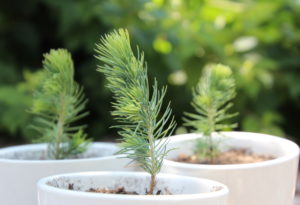 When considering reforestation, the blue spruce is the largest known tree of its species in the country. This tree is recognized not only for its size but also the critical ecosystem services that it provides, such as food and shelter for wildlife, water purification abilities, and its role in absorbing CO2 from our atmosphere and storing carbon in its wood, according to AmericanForests.org.
When considering reforestation, the blue spruce is the largest known tree of its species in the country. This tree is recognized not only for its size but also the critical ecosystem services that it provides, such as food and shelter for wildlife, water purification abilities, and its role in absorbing CO2 from our atmosphere and storing carbon in its wood, according to AmericanForests.org.
Our Vertical Hydroponic Farm (VHF) farm is capable of housing up to 4,800 seeds in the seed table and 4,104 plants in the grow walls. The farm’s climate can be adjusted to provide the ideal temperature, watering schedule, and nutrients for successful tree production. With a germination period of 10-14 days and a 95% success rate, followed by 60 days in the grow walls, FarmBox Foods makes reforestation possible anywhere, anytime, year-round. Annually grow up to 35,000 trees in 320 square feet while using only 3-5 gallons of water per day.
- Efficiently manage the labor of your farm averaging 8-10 hours per week with the ability to remotely monitor your farms conditions.
- One full time employee can effectively manage up to 4 farms, producing up to 140,000 saplings annually.
- Greatly reduces the labor and need for acreage compared to traditional nurseries, while providing the ideal climate needs through any season in any location.
Traditional tree nurseries, when funded under federal or state cost-share programs, are required to have a minimum of 300 well-spaced seedlings per acre (1 acre = 43,560 square feet) in the first growing season. Tree spacing most commonly used ranges from 435 to 726 trees per acre for reforestation purposes as well as wildlife enhancement programs. In the FarmBox Foods Vertical Hydroponic Farm, you can accommodate over 8,900 seedlings and saplings in 320 square feet.
Impacts of climate change
Climate change is leading to unprecedented threats to our forests, including rising temperatures, prolonged drought, increased pests, and larger, more severe wildfires. As of 2021, 128 million acres in the United States have the potential to be reforested. To fulfill half of this need, we have to more than double our current production
National labor shortages are cited as the largest barrier to expanded seedling production. Workforce limitations, including seasonal laborers, are a significant factor across America’s nursery infrastructure. Retiring institutional knowledge is also creating additional barriers for successful operations to continue at today’s demands.
Disease and insect infestation kill more trees annually than forest fires. When temps are high and tree sap is flowing, leaves and fruits are in full bloom. These are all attractants to tree-killing bugs. The recent epidemic of pine beetles is a prime example of the devastation a little bug can wreak on tree populations. Millions of trees were lost to the mountain pine beetle alone over the last 20 years.
Fire is an inevitable part of what makes a forest a forest. However, climate change and other human activity has been enabling even naturally caused fires to occur more frequently and intensely. Wildfires also burn the carbon stored in trees and soil, releasing large amounts of smoke, methane and carbon dioxide into the atmosphere, which impacts the overall global temperature.
Trees grown in a Vertical Hydroponic Farm can have a significant impact on revitalizing these forests and restoring the overall ecosystem.
